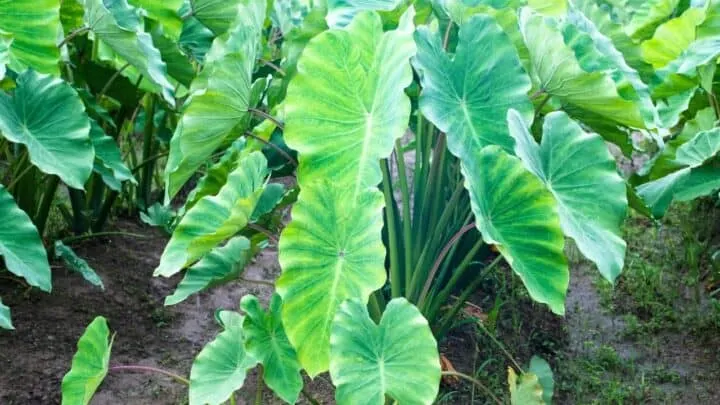You must be thinking that the Taro plant is big and cool, right? Let me tell you more about it, stay with me.
Colocasia esculenta, also commonly known as Taro, belongs to the Araceae family.
The height of Taro is around 3-6 feet (91-183cm). It usually has a main tuber from which roots grow, covered with several others tubers around it.
It is a tropical plant with large leaves, is heart-shaped like the ears of an elephant, and has a touch of lime green color all over it. It’s known to have Asian origins.
Taro is widely eaten across all South Asian and African regions. Its corm has a sweet flavor and is often compared with potatoes.
You can cook it in various recipes, but it is never served raw.
Table of Contents
Colocasia Esculenta Care Guide
Colocasia Esculenta takes around 7 months to mature, with partial sunlight and temperature ranging from 77 to 95 Degree Fahrenheit (25-35 Degree Celsius). It should be watered regularly as it loves wet soil along with high humidity. Keep the soil moist, rich, and well drained. Potassium-based or liquid-based fertilizer is preferred.
Soil
Colocasia esculenta can bear both; dry and wet sites. The only condition is to have rich, well-drained, and moist soil.
Taro is planted 6 inches (15 cm) beneath in trenches with a deep and thick layer of 2-3 inches (5-8 cm) of soil for a dry site.
The pH range needs to be 5.5 to 6.5 for optimal growth. Taro should be planted in spring when both the weather and the soil are warm.
Soil needs to be constantly wet and should be watered often, especially in dry weather.
For healthy growth, the type of fertilizer fed to the soil must be of high potassium, although any other rich organic fertilizer would work too.
Light
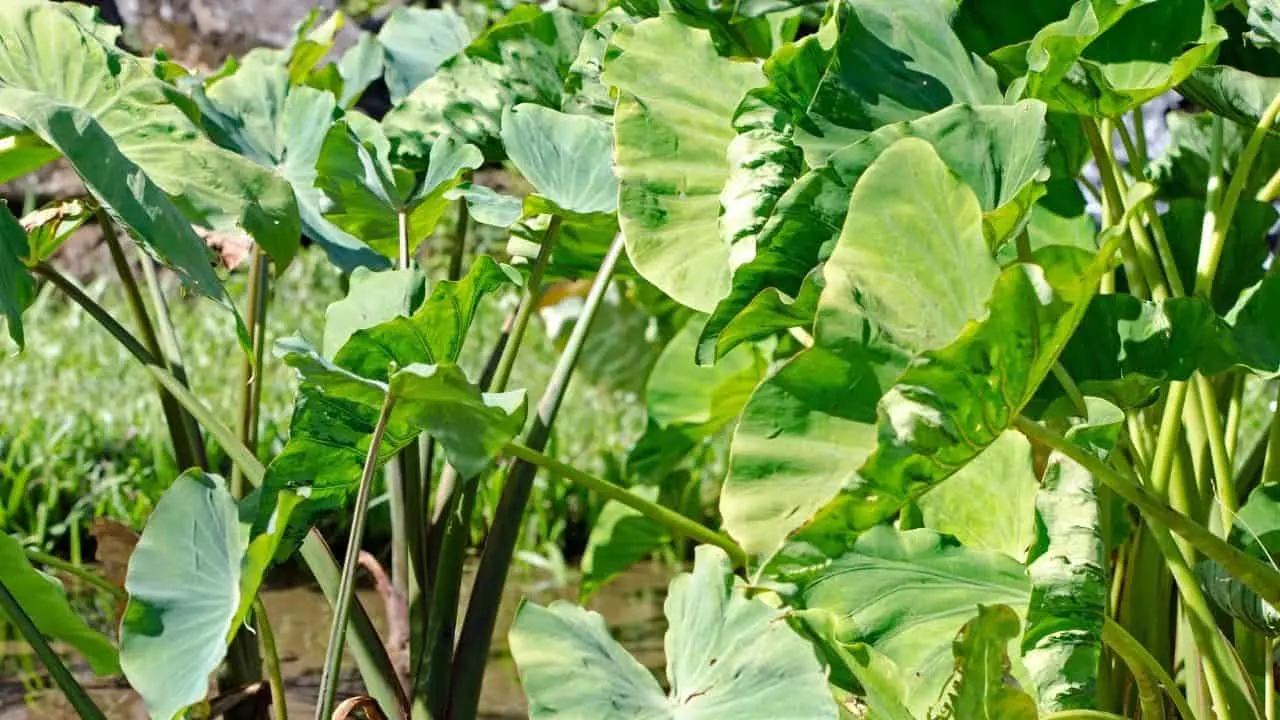
The best condition would be to put it in partial and indirect sunlight. The bright light is perfect for Taro.
If you wish to keep it indoors, it will be fine as long as it gets the bright light. Just protect it from wind and keep it in a dry place in the winter season.
Watering
Colocasia esculenta needs constant watering; to the point that the soil of the taro plant keeps wet.
Water it more often in the dry season and keep it in a place that receives a maximum amount of rainwater.
Ideal rainfall for the Taro plant would be around 1800 to 2700 mm annually.
Clogging is not an issue for the Taro plant as it can handle flooded conditions. Standing water might create some issues because of corms rotting.
Temperature
The ideal condition for growing Taro is in warm and humid weather where the temperature is between 77°F to 95°F (25-35°C).
The average days to its maturity are 200 days without frost. It won’t survive in a cold season below 50°F (10°C), so the summer season needs to be long.
If you have Taro pots in the winter season, bring them indoors and try to give them enough sunlight so that they can thrive properly.
Humidity
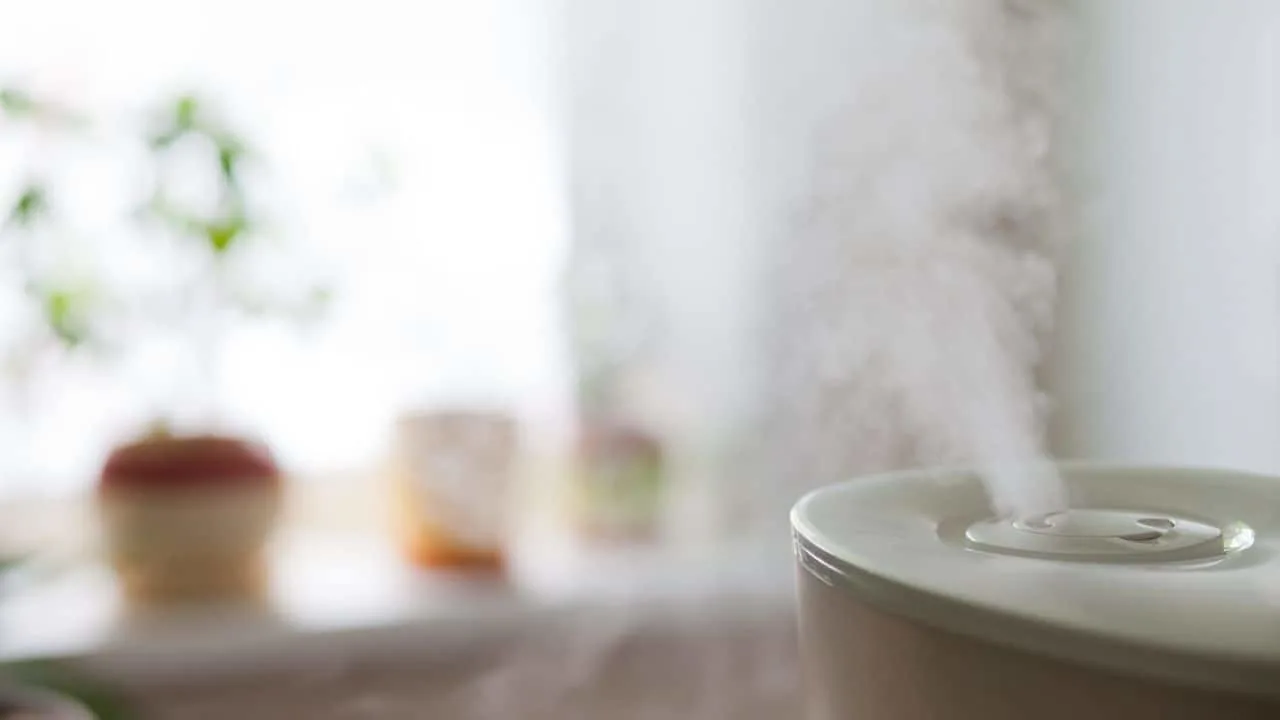
It has a huge impact on Colocasia esculenta as they are most suitable in high humidity.
If indoors, use a humidifier as an alternative so that they can get enough moisture.
Fertilizer
Fertilizer plays an important part in the growth of Taro as it needs to be done several times during the growing season. I would suggest you fertilize it every three weeks.
When planting Colocasia esculenta in-ground, I would suggest using a high potassium fertilizer as it is the best.
Another alternative would be to use any organic material for good growth.
It is not that different for planting it in pots; the key is high humidity for moisture with a combination of liquid seaweed as fertilizer.
This is necessary for its healthy growth and its leaves.
If you are confused about which soil to use, check out the different types of fertilizers for different plants.
Propagation
Colocasia can be propagated by collecting seeds soon after fertilization and sowing them immediately after drying. Seedlings will germinate in 21 days.
Furthermore, you can divide larger corms, collect offsets (cormels) in the running types, or divide plantlets that develop at the rhizome tips.
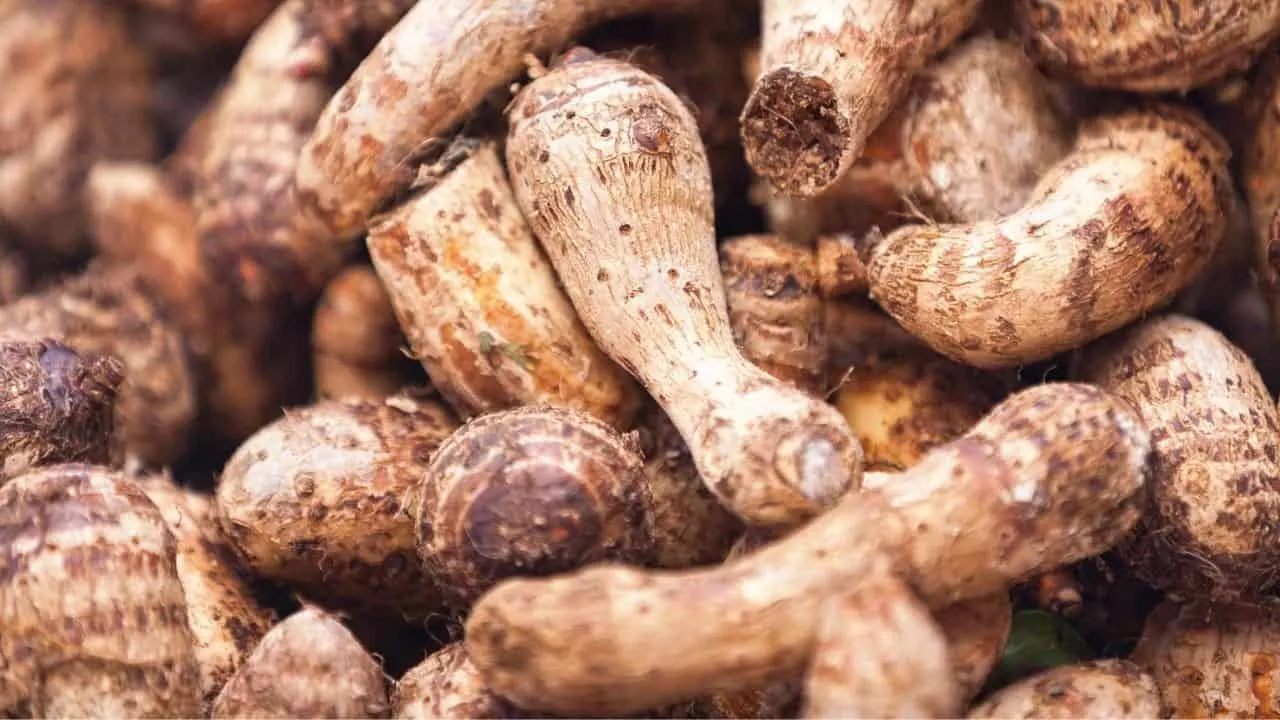
During the course of their growth, the long runners form nodes, at each of which are new growth buds.
Growth
Spring’s the best time to plant Colocasia esculenta as the weather’s warm. Full-grown, mature Taro is about 3 to 6 ft both in width and height.
It takes about 200 days (7 months approx) for it to mature in warm and humid weather and then slows during the winter season.
It takes around 9-12 months for Taro to be fully ready in wetlands. However, it might take around 12-15 months in drylands.
The soonest the first leaf opens, you can now use the taro. When they turn yellow or brown, leaves will die out eventually.
When needed, harvest tubers because they cannot be stored for more than a month but leave them in the ground until then. Also, take them out before the frost.
Spacing
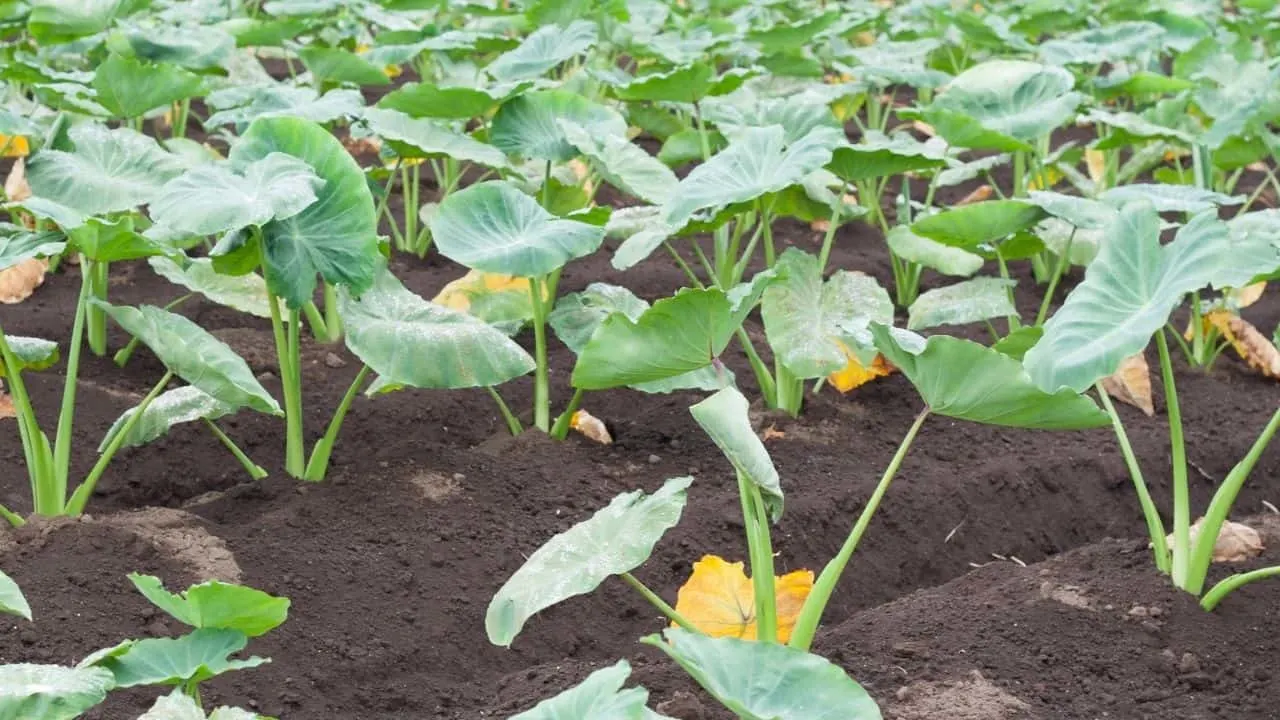
Plant the tubers or offshoots of corm and cover them with soil, as explained above in this article.
The space should be 60-90 cm with 1.8m for rows.
Potting
Taro can be easily planted in a large pot; the only thing you need to have is tubers or colocasia corms to grow. These are some options:
- Grow it in a pot in a greenhouse.
- Grow it indoors. When potting, make sure that it contains a good amount of fertilizer. Although, the foliage is likely going to die if the temperature drops below 21°C.
To keep it safe in pots, you can regularly bring them indoors, keep them in a dry place, and treat them with liquid fertilizer.
The only other thing it needs is sunlight.
Pruning
Check out the stems as soon as they turn yellow or brown because that is when it is time for trimming.
Trim them out and get rid of the excess amount of organic matter.
In the winter season, Taro can be removed and relocated indoors, somewhere warm.
Read Where Do You Cut Plants When Pruning? All You Need to Know! For more details.
Step-by-Step Propagation of Colocasia Esculenta
Propagating the Taro plant can be done in two ways; by tubers or offshoots of mother corm.
For Ground
- Select a site with all the required conditions, such as spring season with warm weather, high humidity, and good soil.
- Dug up a trench about 15 cm deep.
- Plant the tubers directly into them.
- Cover it with soil.
- Tubers will develop in a few days, and a small leaf will grow.
For containers
- Take a huge container, preferably around 5 gallons.
- Take soil and fill it to the top along with some fertilizer.
- Put the taro in the soil.
- Add a thin layer of stones to keep the mosquitoes away.
- Continue to keep the soil wet by adding water to it.
- Have the plant filled with water at all times.
I would prefer to plant them in containers as the need for Taro is not that big for me. Also, it would be easier to relocate it in the winter season.
Tips for Growing Colocasia Esculenta
- An indirect supply of water will affect the growth of Taro. It needs a constant water supply.
- Direct sunlight should be avoided as it can damage the leaves.
- You always need to have moist soil. Avoid excess water as it can be the reason for pesticides.
- Plant at the start of the spring session as it will reach its maturity till late October before the winter season.
- Treat it with high potassium fertilizers every 3 weeks. Use liquid fertilizers for containers.
- Need to have high humidity.
- Plant it somewhere where it might get some rainwater.
- Trim the stem if it turns yellow.
- Don’t leave tubers in frost after harvesting.
- We need to have weed-free planting beds for Taro.
Common Problems with Colocasia Esculenta (Taro)
Taro Leaves Toxicity
Taro leaves are poisonous if eaten raw. The substance that makes it poisonous is high oxalate, which is also present in many plants.
The leaves of the young taro plant are more poisonous than that of an older plant. This is the reason people are advised to wear gloves when handling taro leaves.
Otherwise, it may cause skin irritation.
To make them eatable, boil them or soak them in water to eliminate the poison. Still, people with problems with the kidney are not advised to eat Taro leaves because of oxalate levels.
Pests
Spider Mites
When growing Taro indoors, spider mites can prove to be quite troublesome to deal with.
They make webs on taro leaves and damage their sap. I spray it with neem oil or water for plants.
Some other way they can be handled is through pyrethrin insecticide. These mostly appear to be in hot and dry weather.
Root Knot
This is caused when the parasitic roundworms feed on roots and stop the growth of the plant, causing the plant to turn yellow and making it weak.
They mostly occur in Taro cultivation.
Beneficial nematodes are killed by nematicides, and then the process of weakening begins.
The ways I tackle is to find and eliminate the root-knot nematodes in the soil by leaving beneficial nematodes beforehand.
Another way is to protect from nematode attacks is to relocate and remove any dead plants left in the soil.
Diseases
Phytophthora Blight
The most common disease in Taro plants is leaf blight. It is caused by water-soaked lesions.
If it is not taken care of at the right time, the whole plant will rot and eventually collapse. For preventive measures, try to keep the upper plant of Taro dry.
Other measures include the weekly use of copper fungicide.
Pythium
It is the main cause of rotting corm. This is usually caused by the wet soil as Taro requires a lot of water to grow, so it is not easy to manage.
Once it occurs, it is impossible to get rid of, so to prevent it first is the only option.
I suggest carefully seeing for standing water and preventing it, plant resistant species, and plant healthy corms to avoid pythium.
Downy mildew
The look of downy mildew is like yellow dust on the foliage. It happens when there is humidity and can be the cause of critical damage to your garden.
This is airborne as it travels from one plant to another, damaging everything. Try to control it with copper fungicide or neem oil.
Frequently Asked Questions about Colocasia Esculenta Care Guide
Are Taro leaves poisonous?
Taro leaves cannot be eaten raw as they contain oxalate, which can be poisonous if consumed in high quantity.
Which is more beneficial; Taro or potato?
Taro has more health benefits attached to it. It has more fiber, potassium, and Vitamins B, C, and E than potatoes.
What is the best time to grow Colocasia esculenta?
Spring would be ideal for growing Colocasia esculenta as it is warm and humidity is also there.
What to plant in soil for Taro?
There are two ways to plant Taro; Tubers or Colocasia corms. Either work for planting Taro.
How to harvest tubers?
As soon as the plant reaches its maturity (9-12 months), leaves will turn yellow, and the tuber will be slightly lifted; it means that tubers are ready to be harvested. To extract the tuber, just pluck it out from the ground.
Can we store tubers after harvesting?
The life of tubers after harvesting is around 1 month. If you’re storing it more than that, just leave it on the ground until it’s needed. The only condition is to take it out before frost.
Can Colocasia esculenta be grown indoors?
Colocasia esculenta can be grown in containers easily. You need to have rich soil and liquid fertilizer to keep it healthy.
Conclusion
Taro is a great plant that needs little attention. You can grow it anywhere, even in containers.
It also offers various health benefits and is a good fit for certain cuisines. I would suggest growing Taro in your home.
Just remember to put it in partial sunlight, water it frequently, wash the leaves, or boil it before eating as they are poisonous and can cause irritation.
Good Luck!

Daniel has been a plant enthusiast for over 20 years. He owns hundreds of houseplants and prepares for the chili growing seasons yearly with great anticipation. His favorite plants are plant species in the Araceae family, such as Monstera, Philodendron, and Anthurium. He also loves gardening and is growing hot peppers, tomatoes, and many more vegetables.

